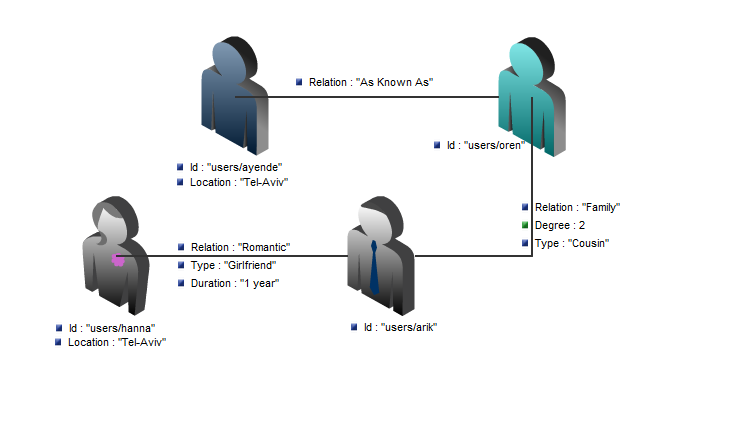I am going to demonstrate the design of the data model in a document database for a typical blog application.
The following is my default sample data model, showing a very simple blog:

The absolutely wrong approach with a document database is to try to take the relational model and apply it on a document level. This is especially wrong because for a while, it might actually work. Let us say that we want to store the following:
var user = new User("ayende");
var blog = new Blog("Ayende @ Rahien", user) { Tags = {".NET", "Architecture", "Databases" } };
var categoryRaven = new Category("Raven");
var categoryNoSQL = new Category("NoSQL");
var post = new Post(blog, "RavenDB", "... content ...")
{
Categories = { categoryRaven, categoryNoSQL },
Tags = {"RavenDB", "Announcements" }
};
var comment = new Comment(post, "Great news");
PersistAll(user, blog, categoryRaven, categoryNoSQL, post, comment);
Interestingly enough, I need to use code to represent the data without tying it to a particular storage format.
The wrong approach to store the data would be to store each object as its own document, similar to the way we would store each object as its own row in a relational database. That wrong approach would look like this:
// users/ayende
{
"type": "user",
"name": "ayende"
}
// tags/1
{
"name": ".NET"
}
// tags/2
{
"name": "Architecture"
}
// tags/3
{
"name": "Databases"
}
// tags/4
{
"name": "RavenDB"
}
// tags/5
{
"name": "Announcements"
}
|
// categories/1
{
"name": "Raven"
}
// categories/2
{
"name" : "NoSQL"
}
// blogs/1
{
"type": "blog",
"users": ["users/ayende"],
"name": "Ayende @ Rahien",
"tags": ["tags/1", "tags/2", "tags/3"]
}
// posts/1
{
"blog": "blogs/1",
"title": "RavenDB",
"content": "... content ...",
"categories": ["categories/1", "categories/2"]
"tags" : ["tags/4", "tags/5"]
}
// comments/1
{
"post": "posts/1",
"content": "Great News"
}
|
I know that I am repeating myself here, but I have seen people miss the point before. Do NOT try to model a document database in this way.
 The main reason that this is wrong is that a document database has no real support for doing joins, unions or any of the things that make such a model work effectively in a relational model.
The main reason that this is wrong is that a document database has no real support for doing joins, unions or any of the things that make such a model work effectively in a relational model.
Let us try to analyze the scenarios where we need this data, okay?
- Main page: show list of blogs
- Main page: show list of recent posts
- Main page: show list of recent comments
- Main page: show tag cloud for posts
- Main page: show categories
- Post page: show post and all comments
- Post page: add comment to post
- Tag page: show all posts for tag
- Categories page: show all posts for category
I am going to analyze each of those scenarios using SQL (and the above model) and the current (and bad, smelly, nasty) document database model. I’ll have another post showing how to correctly model this in a document database, this post is about how not to do it.
Main page: show list of blogs
Using SQL, this is pretty easy:
select * from blogs
Using DocDB, this is easy, we are using a built-in index to query for documents by their type:
docDb.Query<Blog>("DocumentsByType", query:"type:blog");
Main page: show list of recent posts
Using SQL, this is pretty easy:
select * from posts order by PostedAt desc
Using DocDB, we need to define our own index function, to allow use to sort on it. That is painless, even if I say so myself:
from doc in docs
where doc.type == "post"
select new {doc.posted_at}
And now we can query this using:
docDb.Query<Post>("Posts", orderBy:"-posted_at");
Main page: show list of recent comments
This is exactly the same as recent posts, so I’ll skip it.
Main page: show tag cloud for posts
Here the SQL grows interesting:
select Name, COUNT(*) as TagCount from tags
where ItemType = 'Posts'
group by Name
And with the document database we need to write a map/reduce index (“Did you just told me to go @%$# myself?”)
from doc in docs
where doc.type == "posts"
from tag in doc.tags
select new { tag, count = 1 }
from result in results
group result by result.tag into g
select new { tag = g.Key, count = g.Sum(x=>x.count) }
And now that we have the index, we can get the values from it using:
var tagCloud = new TagCloud();
var tagIds = docDb.Query<TagAndCount>("TagsCloud", orderBy:"+count");
foreach(var tagId in tagIds)
{
var tag = docDb.Get<Tag>(tagId.Tag);
tagCloud.Add(tag.Name, tagId.Count);
}
 Now this is ugly on many levels. First, we have the fairly complex index. Second, we have to merge the data ourselves at the client side. Third, we have to perform a SELECT N+1.
Now this is ugly on many levels. First, we have the fairly complex index. Second, we have to merge the data ourselves at the client side. Third, we have to perform a SELECT N+1.
Yuck doesn’t being to cover it. There are actually ways to handle this more nicely, by making a multi get request, but I’ll not bother.
Main page: show categories
Exactly the same as show blogs, so I’ll skip it.
Post page: show post and all comments
Using stupid SQL:
select * from Posts where Id = 1
select * from Comments where PostId = 1
A more efficient method would be to use a join:
select * from Posts
join Comments
on Posts.Id = Comments.Id
where Posts.Id = 1
With the doc db, we can do:
var post = docDb.Get<Post>(1);
var comments = docDb.Query<Comment>("CommentsByPost", query:"post_id:1", orderBy:"+posted_at");
Which, of course, require us to define the comments by post index:
from doc in docs
where doc.type == "comment"
select new{doc.post_id, doc.posted_at}
Note that we have to make two calls here, because a document database has no notion of joins.
Post page: add comment to post
In SQL, it is a straightforward insert:
insert into comments (PostId, ... )
values(1, ...)
And with a document database, you can use:
docDb.Store(new Comment{ PostId = 1, ... });
docDb.SaveChanges();
Nothing much to look at here, using this flawed model.
 Tag page: show all posts for tag
Tag page: show all posts for tag
Using sql, that is slightly complex, because tags may be associated with blogs or with posts, so we need to do:
select * from Posts
where Id in (
select ItemId from tags
where ItemType = 'Posts' and TagId = 1
)
Using a document database:
var posts = docDb.Query<Post>("PostsByTag", query:"tag:tags/1");
With the following index:
from doc in docs
where doc.type == "post"
from tag in doc.tags
select new {tag}
Categories page: show all posts for category
This is exactly like tags, so I’ll skip it.
As you’ve seen, by copying the relational model, we have created just the same sort of environment that we already had with RDBMS, but now we are faced with the problem that a document database can’t do things that a relational database can. In my eyes, what we have done is a net lose. Oh, we may gain some small benefit by being schemaless, but that isn’t really that beneficial in compared to the amount of effort that we have to go to by trying to be relational on a non relational database.









 The main reason that this is wrong is that a document database has no real support for doing joins, unions or any of the things that make such a model work effectively in a relational model.
The main reason that this is wrong is that a document database has no real support for doing joins, unions or any of the things that make such a model work effectively in a relational model.